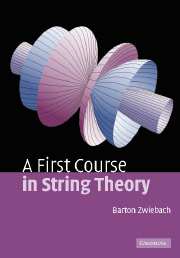Book contents
- Frontmatter
- Contents
- Foreword
- Preface
- Acknowledgements
- Part I Basics
- Part II Developments
- 14 D-branes and gauge fields
- 15 String charge, electric charge, and particle physics
- 16 String thermodynamics and black holes
- 17 T-duality of closed strings
- 18 T-duality of open strings
- 19 Electromagnetic fields on D-branes
- 20 Nonlinear and Born–Infeld electrodynamics
- 21 Covariant string quantization
- 22 String interactions and Riemann surfaces
- 23 Loop amplitudes in string theory
- References
- Index
17 - T-duality of closed strings
from Part II - Developments
- Frontmatter
- Contents
- Foreword
- Preface
- Acknowledgements
- Part I Basics
- Part II Developments
- 14 D-branes and gauge fields
- 15 String charge, electric charge, and particle physics
- 16 String thermodynamics and black holes
- 17 T-duality of closed strings
- 18 T-duality of open strings
- 19 Electromagnetic fields on D-branes
- 20 Nonlinear and Born–Infeld electrodynamics
- 21 Covariant string quantization
- 22 String interactions and Riemann surfaces
- 23 Loop amplitudes in string theory
- References
- Index
Summary
If a spatial dimension is curled up into a circle then closed strings are affected in two ways: their momentum along the circle gets quantized, and new winding states that wrap around the circle arise. The complementary behavior of momentum and winding states, as a function of the radius of the circle, results in a surprising symmetry: in closed string theory, the physics when the circle has radius R is indistinguishable from the physics when the circle has radius α′/R. This equivalence is proven by exhibiting an operator map between the two theories that respects all commutation relations.
Duality symmetries and Hamiltonians
Duality symmetries are some of the most interesting symmetries in physics. The term “duality” is generally used by physicists to refer to the relationship between two systems that have very different descriptions but identical physics. The main subject of this chapter is one such situation that arises in closed string theory. You may think that a world where one dimension is curled up into a circle of radius R could easily be distinguished from a world in which the circle has radius α′/R (recall that α′ has units of length-squared), but in closed string theory these two worlds are indistinguishable for any value of R. There is a duality symmetry that relates them to each other. This symmetry is called T-duality, where the T stands for toroidal.
- Type
- Chapter
- Information
- A First Course in String Theory , pp. 386 - 409Publisher: Cambridge University PressPrint publication year: 2004



